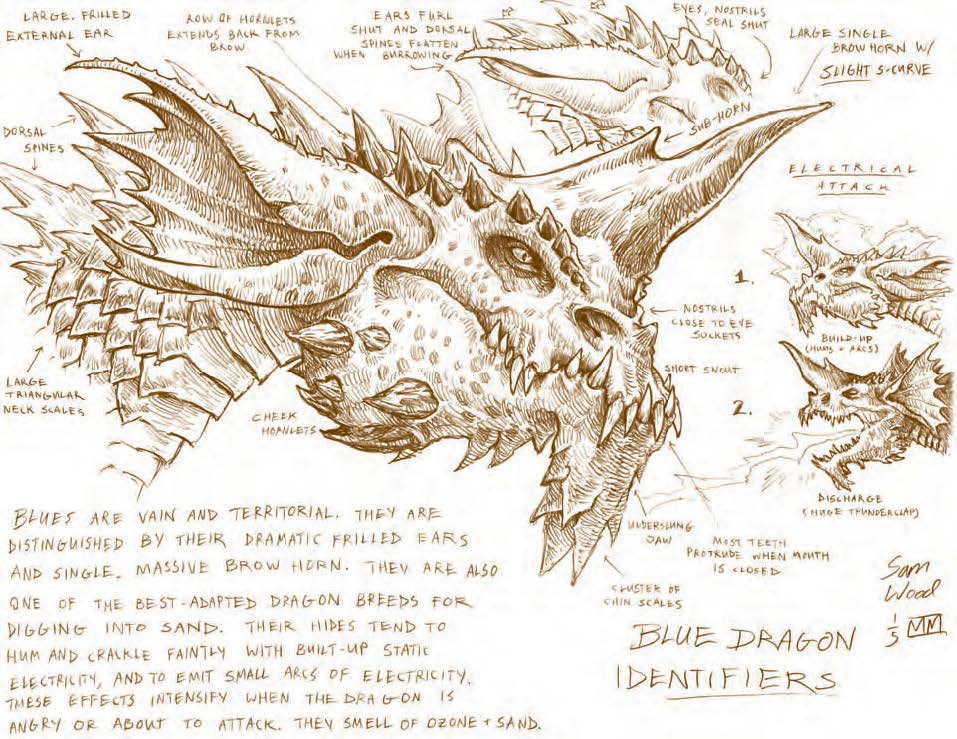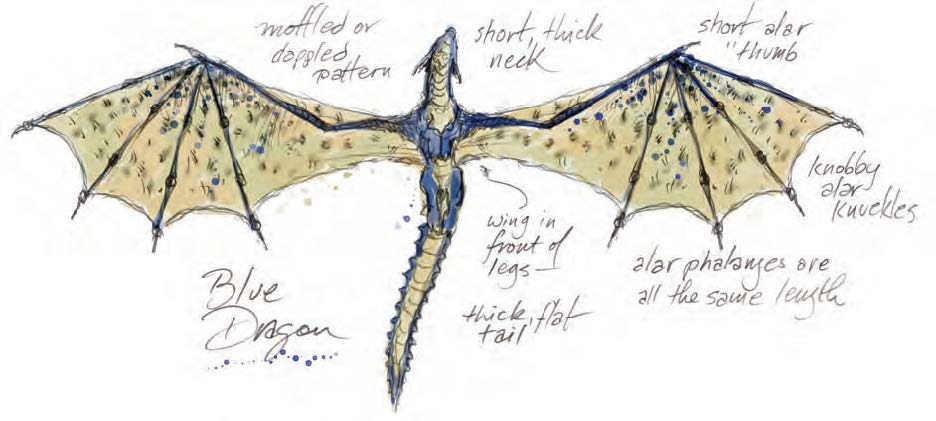Blue Dragon
Blue dragons are vain and territorial. They favor hot, arid areas. They prefer sandy deserts, but can be found on dry steppes and in hot badlands. A blue dragon guards its territory against all potential competitors, including other monsters such as sphinxes, dragonnes, and especially brass dragons. Blue dragons detest brass dragons for their frivolous ways, chaotic alignment, and propensity to flee from battle.
Blue dragons prefer vast underground caverns for lairs— the grander the cavern, the better. They often choose lairs at the bases of cliffs where windblown sand has accumulated. The dragon burrows through the sand to reach the caves below. Most blue dragons don’t bother to keep the entrances to their lairs free of sand; they simply burrow to get in or out. Many deliberately bury the entrances to their lairs before settling down to sleep or when leaving to patrol their territory. Dungeon-dwelling blue dragons prefer fairly warm and dry areas with sand or dirt floors.
Blue Dragon Identifiers
A blue dragon is conspicuous by its dramatic frilled ears and a single, massive horn atop its short, blunt head. The horn juts forward from a base that takes up most of the top of the head, and it usually has two points. The primary point is slightly curved and reaches well forward, with a smaller, secondary point behind. Rows of hornlets line the dragon’s brow ridges, and run back from the nostrils (which lie close to the eyesockets) along the entire length of the head. A blue dragon has a short snout with an underslung lower jaw. It has a cluster of bladelike scales under its chin, and hornlets on its cheeks. Most of the dragon’s teeth protrude when its mouth is closed. A blue dragon’s scales vary in color from an iridescent azure to a deep indigo, polished to a glossy finish by blowing desert sands. The size of its scales increases little as the dragon ages, although they do become thicker and harder. Its hide tends to hum and crackle faintly with built-up static electricity. These effects intensify when the dragon is angry or about to attack, giving off an odor of ozone and sand. A blue dragon flying overhead is easily distinguished from a brass dragon by its batlike wings, which have short alar thumbs and a mottled or dappled pattern. The alar phalanges (the fingerlike bones that support the wing) have knobby joints, and the phalanges are all the same length, giving the wings a rounded look. The trailing edge of the wing membrane joins the body well ahead of the rear legs. The dragon has a short, thick neck. The head is mostly featureless when viewed from below, but the ears are visible. The dragon’s tail is thick and flat.Habits
A blue dragon’s vibrant color makes it easy to spot in barren desert surroundings, especially when the dragon is on the ground. When it wishes to be less conspicuous, a blue dragon burrows into the sand so that only the top of its head is exposed. This trick leaves the dragon’s massive horn sticking above the surface, but from a distance the horn tends to look like a jagged rock. Blue dragons love to soar in the hot desert air, usually flying in the daytime when temperatures are highest. Some nearly match the color of the desert sky and can be difficult to see from below. Although they collect anything that looks valuable, blue dragons are most fond of gems—especially blue sapphires. They consider blue to be a noble hue and the most beautiful color. Blue dragons are dedicated carnivores. They sometimes eat snakes, lizards, and even desert plants to sate their great hunger, but they especially prefer herd animals such as camels. When they get the chance, they gorge themselves on these creatures, which they cook with their lightning breath. This dining habit makes blue dragons a real threat to caravans crossing the desert. The dragons think of caravansas handy collections of food and treasure, all available on the same trip. Blue dragons have a highly developed sense of order (with themselves at the top, at least locally). The oldest blue dragon in an area acts as an overlord to all lesser blue dragons living nearby. This suzerain receives homage from its subjects and settles any disputes, particularly those involving mates or territorial boundaries. Although any blue dragon in an area can challenge the suzerain for the right to rule, this seldom happens. A blue dragon that is unhappy with its suzerain usually moves to a new area—either one with a suzerain more to its liking, or one with no suzerain at all. Blue dragons observe elaborate courtship and mating rituals involving exchanges of food and treasure, the consent of the suzerain, and announcements to other blue dragons. Older dragons of either sex might have multiple mates, but infidelity is rare. Blue dragons are usually attentive and effective parents, and do not often leave eggs unattended. Typically, blue dragons attack from above or burrow beneath the sands until opponents come within 100 feet. Older dragons use their special abilities, such as hallucinatory terrain, in concert with these tactics to mask the land and improve their chances to surprise the target. When stalking intelligent prey, they often use ventriloquism and mimicry to confuse and divide groups before closing in for the kill. A blue dragon runs from a fight only if it is severely damaged, since all blue dragons view retreat as cowardly.Sources:
- Dungeons & Dragons Draconomicon (3.5 Edition, 2009).
- Monster Manual, Blue Dragon
Related Ethnicities




Comments